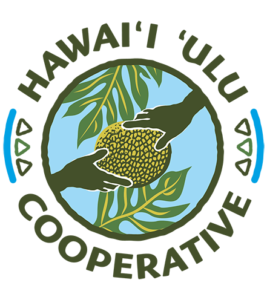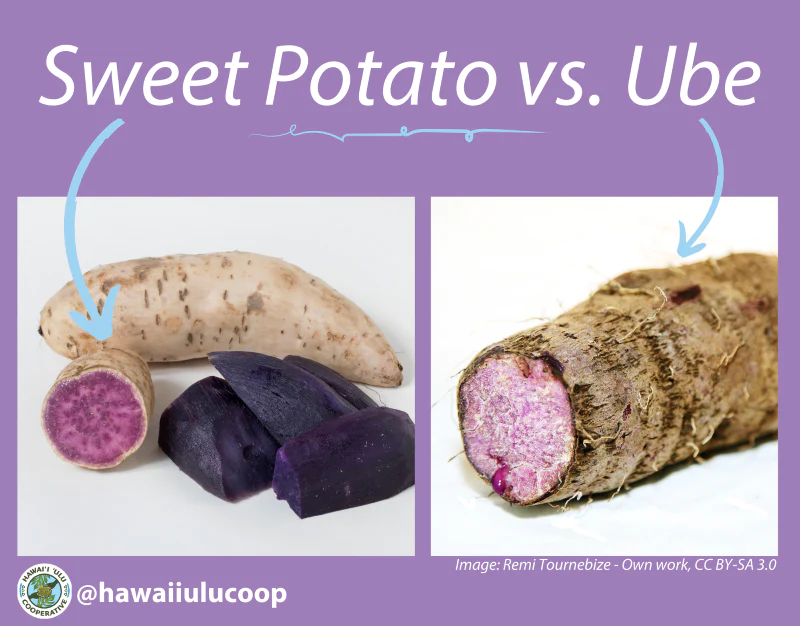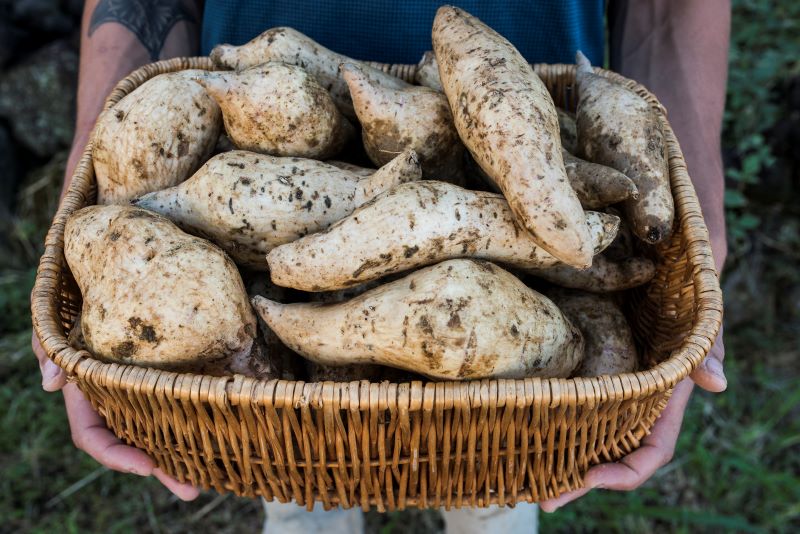What is the Difference Between Purple Sweet Potato and Ube?
Is Ube the same thing as a purple Okinawan sweet potato?
It can be easy to confuse Okinawan sweet potatoes and ube – a type of yam – because of their rich purple color, but make no mistake, they are two different ingredients.
Here are some of the major taste, nutrition, and biological differences and similarities between these two crops. Even with their differences, substituting purple sweet potatoes for ube works great in a pinch. Only a true connoisseur will taste the subtle difference.
Okinawan Sweet Potato
ʻUala, or sweet potatoes, were brought to Hawaiʻi by Polynesian voyagers. Before European contact there were over 200 varieties of ʻuala in Hawaiʻi.
The Okinawan sweet potato variety originated in South America and was brought to Japan in the 1600’s, with the first plantings in Okinawa. These purple tubers were brought to Hawai‘i with Japanese sugar plantation workers in the early 1900s and have since become a local favorite.
Ube
Ube is Tagalog – the national language of the Philippines – for the purple yam native to Southeast Asia that has since been naturalized in South America, Africa, Australia, and the southeastern United States. It is also known as the “winged” or “water” yam in English.
Uhi – a Hawaiian yam – is a canoe crop of the same species as ube (Dioscorea alata). Very popular in the Philippines, ube is used in many traditional dishes and modern desserts, such as ice cream and cake. While ‘uala is an important staple crop in Hawai’i, uhi never achieved this status.
Interested in growing ube? Check out HIP Agriculture’s informative planting video to learn about growing your own ube!
Taste and Texture
- Both ube and Okinawan sweet potato have a similar sweet, earthy flavor, with ube carrying hints of pistachio and vanilla.
- Sweet potatoes have a drier texture while ube is more moist; some have even likened ube to an Irish potato!
- In Hawaiʻi, one traditional differentiator is that ʻuala can be made into poi by adding water, while uhi is not sticky enough and too mealy to create poi.
Nutrition
- Why are ube and Okinawan sweet potatoes both so purple? Their purple coloring actually comes from anthocyanins, powerful antioxidants which help to guard against cardiovascular disease and cancer.
- Okinawan sweet potato has a lower Glycemic Index than ube does (46 vs.79), meaning it is less likely to cause large increases in blood sugar levels and may support weight loss and prevent chronic diseases related to obesity – such as diabetes and cardiovascular disease.
Plant Biology
- The skin of Okinawan sweet potato is thin, like an Irish potato, and can be eaten. Ube has a thick, bark-like skin, which allows the crop to store for longer, but is unpleasant to eat.
- Okinawan sweet potatoes are in the morning glory family and completely unrelated to yams, such as ube.
- Yams, such as ube and uhi, take a full year’s cycle to grow a crop while purple sweet potatoes mature quickly, in just about 3 to 7 months.
While ube may be hard to find, boosting your diet with nutritious bright purple colors is easy with our steamed and frozen ʻuala. Check out our Farm-to-Table Sweet Potato Gnocchi home recipe for a rich dish packed with antioxidants that is simple to make!


